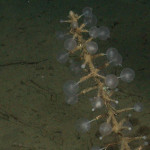An occasional series where we briefly report 3 new studies and tell you why they are cool!
A new report from Lambert et al. reports on a new fossil sperm whale skull, teeth, and mandible from Peru. Dating back to the 12-13 Mya from the Middle Miocene, Leviathan melvillei possessed a 3 meter (~10 feet) long head making it considerably larger than modern sperm whales. Indeed, this fossil represents one of the largest raptorial predators, a predatory strategy with adaptations for catching and holding prey, and the biggest tetrapod bites ever found.Because the appearance of this super sperm whale coincided with the diversification and increase in body size of baleen whales, Leviathan melvillei plausibly fed on other whales.
Why is this paper cool? From the paper itself, not the press release…”This sperm whale could firmly hold large prey with its interlocking teet, inflict deep wounds and tear large pieces from the body of the victim.” Now that’s science writing!
Lambert, O., Bianucci, G., Post, K., de Muizon, C., Salas-Gismondi, R., Urbina, M., & Reumer, J. (2010). The giant bite of a new raptorial sperm whale from the Miocene epoch of Peru Nature, 466 (7302), 105-108 DOI: 10.1038/nature09067
_________________________________
A time lag may occur between an anthropogenic effect, i.e. habitat loss, and the eventual disappearance of a species. During this lage species are survived but ultimately doomed. This is an extinction debt. This extinction debt can arise because the reduction of species to a few surviving individuals makes them more prone to stochastic factors, e.g. climatic variation that reduces food, desease, erosion of genetic variability. Obviously, calculating extinction debt is fraught with difficulty requiring an accurate and specific knowledge of extinction rate. This is often not available. One way to calculate the impact of habitat loss is by using an equation that relates the size of area to the number of species is possesses. We know that larger areas typically possess more species. On average, a 10-fold decrease in area leads to a 2-fold decrease in species. However, this depends on the exact slope of the relationships between area and the number of species which is again often unknown. A new study on insects of the Azores quantifies extinction debt from the 95% loss of native forests in the last 600 years. The authors find the extinction debt of the insects on the Azores is nearly half of the extant species.
Why is this paper cool? The authors are very clever in how the figure the extinction debt. Knowing the area of the forest at each four points in time (1440, 1700, 1850, and 2000) for the different islands, the authors can calculate at which time the best fit is obtained between the current number of species on the islands and area of the forests in the past. The forest area at given time intervals in which the best fit is obtained represents the baseline. The reductions of forest area since and the corresponding reduction of species can be calculated.
Triantis, K., Borges, P., Ladle, R., Hortal, J., Cardoso, P., Gaspar, C., Dinis, F., Mendonça, E., Silveira, L., Gabriel, R., Melo, C., Santos, A., Amorim, I., Ribeiro, S., Serrano, A., Quartau, J., & Whittaker, R. (2010). Extinction debt on oceanic islands Ecography DOI: 10.1111/j.1600-0587.2010.06203.x
_________________________________
The queen of hydrothermal vents, Dame of the Deep, Cindy Lee Van Dover recently published a call to arms for conservation science at hydrothermal vents. This comes in response to the potential for intense exploitation of vents for the mining of massive sulphide deposits. Her three recommendations include 1) determining what we need to conserve 2) develop a specific set of conservation area design recommendations based on our best knowledge and 3) develop and test methods for effective mitigation and restoration strategies.
Why is this paper cool? In time of unprecedented interest in and exploration of the deep, more deep-sea scientists need to voice concerns, criticisms, and put forth the best science to guide regulation and conservation at the seafloor. Van Dover’s statements are backed from an expansive and impressive science career at the cutting edge of vent science. Her paper is an elegantly written, insightfully specific, and open-access proclamation.
Van Dover, C. (2010). Mining seafloor massive sulphides and biodiversity: what is at risk? ICES Journal of Marine Science DOI: 10.1093/icesjms/fsq086
Share the post "The Tide Pool: Super Sperm Whales, Extinction Debts, and Vent Conservation"






Minor typo: the new sperm whale genus is “Leviathan”, not “Leviantha”.
Dave,
Thanks for the catch
Oh, I like this series!